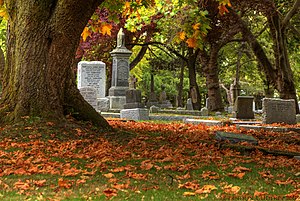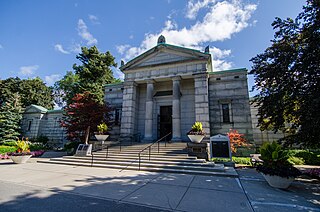
Mount Pleasant Cemetery is a cemetery located in Toronto, Ontario, Canada, and is part of the Mount Pleasant Group of Cemeteries. It was opened in November 1876 and is located north of Moore Park, a neighbourhood of Toronto. The cemetery has kilometres of drives and walking paths interspersed with fountains, statues and botanical gardens, as well as rare and distinct trees. It was originally laid out by German-born landscape architect Henry Adolph Engelhardt, inspired by the European and American garden cemeteries of the 19th century, and with influences from Mount Auburn Cemetery in Boston.
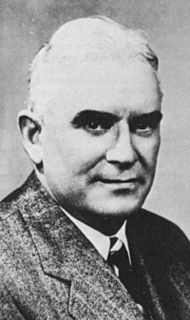
Byron Ingemar "Boss" Johnson, served as the 24th premier of British Columbia, from 1947 to 1952. To his contemporaries he was often referred to by his nickname, Boss Johnson, which had nothing to do with his personality, but was an anglicization of the Icelandic "Bjossi", which is a diminutive form of his birth-name of Bjorn, which was adapted into English as Byron.

Edward Gawler Prior, was a mining engineer and politician in British Columbia.
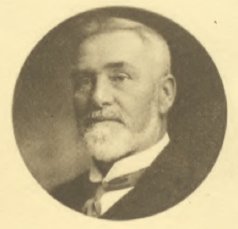
James Dunsmuir was a Canadian industrialist and politician in British Columbia. He served as the 14th premier of British Columbia from 1900 to 1902 and the eight lieutenant governor of British Columbia from 1906 to 1909.

Alexander Edmund Batson Davie, QC, referred to as A. E. B. Davie, was the eighth premier of British Columbia. He served in office from 1887 until his death in 1889.

Robert Beaven, son of James Beaven, was a British Columbia politician and businessman. Beaven moved to British Columbia from Toronto, where he had been educated at Upper Canada College, because of the gold rush. He entered business in Victoria, which was then the capital of the Colony of Vancouver Island. After the colony's union with British Columbia, Beaven became involved with politics as secretary of Amor De Cosmos' Confederation League which advocated that the colony enter Canadian Confederation.
Port McNeill is a town in the North Island region of Vancouver Island, British Columbia, Canada with a population of 2,356 (2021). Located on Vancouver Island's north-east shore on Queen Charlotte Strait, it was originally a base camp for loggers. Port McNeill became a settlement in 1936. The town was named after Captain William Henry McNeill of the Hudson's Bay Company.

Opened in 1852, Mount Royal Cemetery is a 165-acre (67 ha) terraced cemetery on the north slope of Mount Royal in the borough of Outremont in Montreal, Quebec, Canada. Temple Emanu-El Cemetery, a Reform Judaism burial ground, is within the Mount Royal grounds. The burial ground shares the mountain with the much larger adjacent Roman Catholic cemetery, Notre Dame des Neiges Cemetery, and the Shaar Hashomayim Cemetery, an Ashkenazi Jewish cemetery. Mount Royal Cemetery is bordered on the southeast by Mount Royal Park, on the west by Notre-Dame-des-Neiges Cemetery, and on the north by Shaar Hashomayim Cemetery.
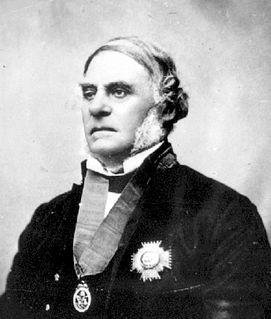
Sir James Douglas was a British Columbian fur trader and politician who became the first Governor of the Colony of British Columbia. He is often credited as "The Father of British Columbia." He was instrumental to the resettlement of 35 African-Americans fleeing a life of racial persecution in San Francisco who arrived in the province aboard the steampship Commodore in what later became known as the Pioneer Committee. In 1863, Douglas was knighted by Queen Victoria for his services to the Crown.

Sir Matthew Baillie Begbie was a British lawyer, politician, and judge. In 1858, Begbie became the first Chief Justice of the Crown Colony of British Columbia in colonial times and in the first decades after British Columbia joined Confederation as a province of Canada.

Joseph Despard Pemberton was a surveyor for the Hudson's Bay Company, Surveyor General for the Colony of Vancouver Island, a pre-Confederation politician, a businessman and a farmer. He was born in 1821 in Dublin, Ireland and died in 1893 in Oak Bay, British Columbia. Joseph Pemberton laid out Victoria's town site, southern Vancouver Island and townsites along the Fraser River. He married Teresa Jane Grautoff and they are the parents of Canadian painter Sophie Pemberton. The town of Pemberton was named after him.
Fairfield is a neighbourhood of Victoria, British Columbia. It is bounded by the James Bay, Downtown, Harris Green, Fernwood, Rockland, and Gonzales neighbourhoods, and meets the Strait of Juan de Fuca to the south.

Mountain View Cemetery is the only cemetery in the City of Vancouver, British Columbia. Opened in 1886, it is located west of Fraser Street between 31st and 43rd Avenues. It is owned and operated by the City of Vancouver and occupies 0.43 square kilometres of land, containing more than 92,000 grave sites and over 145,000 interred remains. The first interment took place on February 26, 1887. The first interment was supposed to happen in January 1887 but poor weather, a new road, and a broken wagon wheel resulted in the intended first occupant being temporarily buried outside the cemetery. His body was relocated to inside the cemetery months later.
William Henry McNeill was best known for his 1830 expedition as the captain of the brig Llama, which sailed from Boston, Massachusetts, United States, 12,000 miles (19,000 km) around Cape Horn, to the Pacific Northwest on a maritime fur trade expedition.
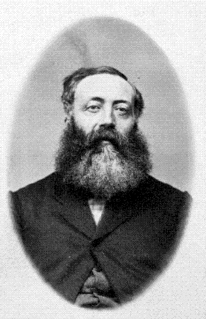
Sir Henry Pering Pellew Crease was a British-Canadian lawyer, judge, and politician, influential in the colonies of Vancouver Island and British Columbia. He was the first Attorney General of the united Colony of British Columbia, and sat on the Supreme Court of that province for 26 years.
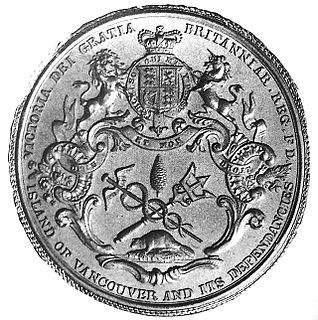
The Legislative Assembly of Vancouver Island, sometimes House of Assembly of Vancouver Island, was the colonial parliamentary body that was elected to represent voters in the Colony of Vancouver Island. It was created in 1856 after a series of petitions were sent to the Colonial Office in London protesting the Hudson’s Bay Company’s proprietary rule over the colony. It was the first elected assembly in British North America west of Ontario. Although at first only handful of colonists met the voting requirement, and most of those that did were tied to the HBC, the franchise was gradually extended, and the assembly began to assert demands for more control over colonial affairs, as well as criticize colonial governor Sir James Douglas's inherent conflict of interest as both governor and Hudson Bay Company's chief factor.

Roderick Finlayson was a Canadian Hudson's Bay Company officer, farmer, businessman, and politician.
South Oak Bay is a neighbourhood located in the Municipality of Oak Bay, British Columbia, to the south of Oak Bay Avenue and lying east of the boundary between Oak Bay and Victoria, British Columbia.
Isabella Mainville Ross was the first female registered landowner in British Columbia. She was a Métis woman, the daughter of Joseph and Josette Mainville.
